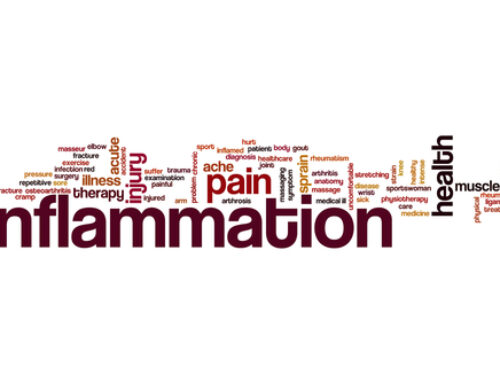Are you in chronic pain? Do you have pain in a joint or muscle that seems to come out of nowhere? Is your cholesterol, blood pressure or triglycerides too high? Do you have arthritis that keeps you from doing the things that you want to do? Do you struggle to get enough sleep? Are you chronically stressed? Do you struggle to lose weight, in spite of your best dietary changes? Do you have a skin or bowel disorder that does not go away? Are you aging faster than you think you should be? If you have been asking yourself these questions lately, there may be one underlying question that you need to ask yourself, ‘Are you inflamed?’
Are you inflamed?
If you answered yes to any of the above questions, you are showing signs of inflammation. We refer to these conditions often as diseases or health problems and we wonder ‘How did this happen?’ Or ‘Why did I get such a disease?’ Frequent lifestyle choices can create these conditions and lead you to an inflamed state.
If you take over-the-counter anti-inflammatories, regularly eat refined sugar or drink sodas, regularly eat refined flours, regularly eat hydrogenated oils or vegetable oils, or regularly eat moderate amounts of dairy products, you are heading toward inflammation.
What about exercise? Lack of regular exercise or excessive amounts of exercise can also lead to inflammation. Changing our daily inflammatory habits should be everyone’s goal, resulting in the improvement and elimination of many inflammation symptoms, diseases, and an improved overall health.
Can you measure inflammation?
The best blood test for measuring inflammation is a C-reactive protein test. This test is helpful to quantify the amount of inflammation in your body. It is estimated that 25% of the US population is highly inflamed and will have a test marker above 3mg/l. The average American has a test marker of 1.5mg/L but anything under 1mg/L is preferred. Vitamin D is another blood test that can be used to measure inflammation due to the vitamin’s anti-inflammatory actions. A blood level below 60ng/ml is often associated with an inflamed state.
Likewise, you can measure blood pressure, cholesterol, triglycerides, blood sugar, and waist circumference to assess a specific state of inflammation known as ‘Metabolic Syndrome.’ Metabolic Syndrome is a collection of marker signs that have been grouped together because of their predictive value of diabetes, cardiovascular disease, cancer, arthritis and more. One of the more telling measurements of the syndrome is the waist circumference. Men with a waist size over 40” and women with a waist size over 35” possess one positive marker. If anyone is abnormal in 3 out of 5 of the above markers, they are diagnosed with Metabolic Syndrome and their likelihood of disease and death are greatly increased.
Inflammation and pain?
It has been well reported that inflammation levels will rise with infection and trauma. Similarly, inflammatory levels rise with a high stress day, less than 6 hours of sleep, or one fast-food meal. Perhaps only one high stress day, or one sleepless night, or just one fast-food meal does not cause a long term problem, but a lifestyle of such insults will create a state of chronic inflammation and disease. Most of us think of inflammation in relation to a sprained ankle or back muscle. The redness, swelling, warmth, and pain of an injured soft tissue is the hallmark signs of inflammation. However, these are not the only signs of inflammation that could be robbing you of your health.
 For example: A 50 year old male has chronic anterior knee pain, referred to as patellar tendonitis. This soft-tissue injury is frequently associated with those who exercise regularly, particularly with high impact exercises such as tennis. However, our patient does not exercise. He is slightly overweight, eats the typical American diet, works long hours, has three kids, and gets a few hours of sleep each night. His blood pressure is borderline high and he has some digestive complaints on occasion. His question is: “How did I hurt my knee?”
For example: A 50 year old male has chronic anterior knee pain, referred to as patellar tendonitis. This soft-tissue injury is frequently associated with those who exercise regularly, particularly with high impact exercises such as tennis. However, our patient does not exercise. He is slightly overweight, eats the typical American diet, works long hours, has three kids, and gets a few hours of sleep each night. His blood pressure is borderline high and he has some digestive complaints on occasion. His question is: “How did I hurt my knee?”
It is now known that patellar tendonitis and degenerative knee pain can be observed in individuals who do no physical activity but stay in a constant state of dietary induced inflammation. One study found that patients with waistlines greater than 33 inches in men and 28 inches in women had a much greater risk of patellar tendonitis regardless of their activity levels, due to inflammation. This same relationship has been identified in Achilles, elbow and shoulder tendons. Many researchers are now changing their view on tendinopathy causes to include diet-related inflammation.
The Inflammation-Obesity-Inflammation Cycle
 When a lean person has an occasional stressful day, sleepless night, or fast food meal, they will experience a short term inflammatory state. Inflammation can be cleared by the body’s detoxification and immune systems. However, when these episodes become chronic, metabolism slows down causing the storage of excess calories that we refer to as fat. Our American society nearly guarantees that its citizens will increase their fat storage based upon our high stress, constantly moving society that persists mainly on convenience-based foods.
When a lean person has an occasional stressful day, sleepless night, or fast food meal, they will experience a short term inflammatory state. Inflammation can be cleared by the body’s detoxification and immune systems. However, when these episodes become chronic, metabolism slows down causing the storage of excess calories that we refer to as fat. Our American society nearly guarantees that its citizens will increase their fat storage based upon our high stress, constantly moving society that persists mainly on convenience-based foods.
As fat storage increases, the accumulation of the adipose tissue alters normal hormone production. This has an affect on cardiovascular healing, insulin sensitivity, immune function, and greater inflammation systemically. This hormonal disruption also greatly reduces the ability of the muscles to burn body fat and regulate the feeling of satisfaction when eating. In short, inflammation creates body fat accumulation and this in turn decreases metabolism, increases inflammation, and causes us to want to eat more. This cycle can be broken but progress can be slow until the state of inflammation is greatly reduced.
Changing Your State Of Mind
Changing the state of your inflammation begins with a change of mind. Changing your state of mind begins with keeping your goals in sight. Lifestyle changes fail when we focus on what we can’t have, but can succeed when we focus on where we want to go. A great question to ask when choosing what to eat or drink next is, “Does this help me get to my goal?” Focusing on the foods, drinks, and supplements that can reduce inflammation and promote health and healing gives you the power to take control of your health.
In the next part of our blog series, we will discuss what foods, drinks, supplements, and lifestyle choices can help to reduce inflammation. We will focus on tasty snacks, easy meals, and a rescue plan when inflammation is raging. Also, look for our “Fight Inflammation” class on September 15 at 6:30pm at our office. To register for the class, email the office at FrontDesk@CoreRoanoke.com or sign up inside the office. Seating is limited, so please do not delay.

Daryl C. Rich, D.C., C.S.C.S.






